
An echinoderm is any member of the phylum Echinodermata. The adults are recognisable by their radial symmetry, and include starfish, brittle stars, sea urchins, sand dollars, and sea cucumbers, as well as the sea lilies or "stone lilies". Adult echinoderms are found on the sea bed at every ocean depth, from the intertidal zone to the abyssal zone. The phylum contains about 7,000 living species, making it the second-largest grouping of deuterostomes, after the chordates. Echinoderms are the largest entirely marine phylum. The first definitive echinoderms appeared near the start of the Cambrian.
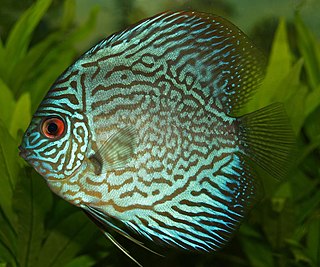
Symphysodon is a genus of cichlids native to the Amazon river basin in South America. Due to their distinctive shape, calm behavior, many bright colors and patterns, and dedicated parenting techniques, discus are popular as freshwater aquarium fish, and their aquaculture in several countries in Asia is a major industry. They are sometimes referred to as pompadour fish. The discus fish has attracted a cult following of collectors and has created a multimillion dollar international industry complete with shows, competitions, and reputable online breeders.

Starfish or sea stars are star-shaped echinoderms belonging to the class Asteroidea. Common usage frequently finds these names being also applied to ophiuroids, which are correctly referred to as brittle stars or basket stars. Starfish are also known as asteroids due to being in the class Asteroidea. About 1,900 species of starfish live on the seabed in all the world's oceans, from warm, tropical zones to frigid, polar regions. They are found from the intertidal zone down to abyssal depths, at 6,000 m (20,000 ft) below the surface.

A keystone species is a species that has a disproportionately large effect on its natural environment relative to its abundance, a concept introduced in 1969 by the zoologist Robert T. Paine. Keystone species play a critical role in maintaining the structure of an ecological community, affecting many other organisms in an ecosystem and helping to determine the types and numbers of various other species in the community. Without keystone species, the ecosystem would be dramatically different or cease to exist altogether. Some keystone species, such as the wolf, are also apex predators.

Asterias is a genus of the Asteriidae family of sea stars. It includes several of the best-known species of sea stars, including the (Atlantic) common starfish, Asterias rubens, and the northern Pacific seastar, Asterias amurensis. The genus contains a total of eight species in all. All species have five arms and are native to shallow oceanic areas of cold to temperate parts of the Holarctic. These starfish have planktonic larvae. Asterias amurensis is an invasive species in Australia and can in some years become a pest in the Japanese mariculture industry.

The crown-of-thorns starfish, Acanthaster planci, is a large starfish that preys upon hard, or stony, coral polyps (Scleractinia). The crown-of-thorns starfish receives its name from venomous thorn-like spines that cover its upper surface, resembling the biblical crown of thorns. It is one of the largest starfish in the world.

Charonia is a genus of very large sea snail, commonly known as Triton's trumpet or Triton snail. They are marine gastropod mollusks in the monotypic family Charoniidae.
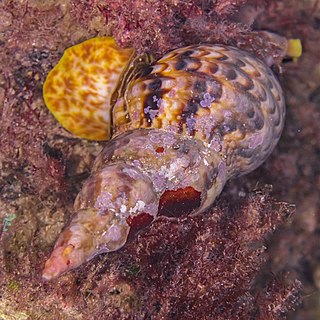
Charonia tritonis, common name the Triton's trumpet, the giant triton or pū is a species of very large sea snail, a marine gastropod mollusc in the family Charoniidae, the tritons. Reaching up to two feet in shell length this is one of the biggest mollusks in the coral reef.
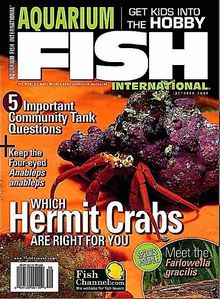
Aquarium Fish International (AFI) was a North American monthly magazine, published by BowTie Inc. of Irvine, California, and dedicated to freshwater and saltwater fishkeeping and the aquarium/fishkeeping hobby in general.

The common starfish, common sea star or sugar starfish is the most common and familiar starfish in the north-east Atlantic. Belonging to the family Asteriidae, it has five arms and usually grows to between 10–30 cm across, although larger specimens are known. The common starfish is usually orange or brownish in color, and sometimes violet; specimens found in deeper waters are pale. The common starfish is found on rocky and gravelly substrates where it feeds on mollusks and other benthic invertebrates.

Stichaster australis, the reef starfish, is a species of starfish found in the shallow waters of the rocky intertidal of New Zealand. Typically, the animal is endemic to the west coast shores of the North and South Islands, where wave action is increased. They do not usually inhabit ecosystems that have reduced wave action and calm conditions as they prefer a higher-energy environment. These marine invertebrates range in color from pink to purple, but can also be orange. They typically have eleven arms, but sometimes they may have either ten or twelve. As full-grown adults, they are 8 to 10 cm in diameter.

Solaster dawsoni, the morning sun star, is a species of starfish in the family Solasteridae. It is found on either side of the northern Pacific Ocean. It has two subspecies:

Asterias forbesi, commonly known as Forbes sea star, is a species of starfish in the family Asteriidae. It is found in shallow waters in the northwest Atlantic Ocean and the Caribbean Sea.

The Astropecten articulatus, more commonly known as the Royal Starfish, is a West Atlantic sea star of the family Astropectinidae.
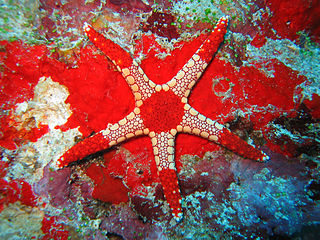
Fromia monilis, common name necklace starfish or tiled starfish, is a species of starfish belonging to the family Goniasteridae.
Parvulastra parvivipara is a very small species of starfish in the family Asterinidae. It is a viviparous species and gives birth to live young. It lives in rock pools on intertidal granite rocks in a limited area of South Australia.
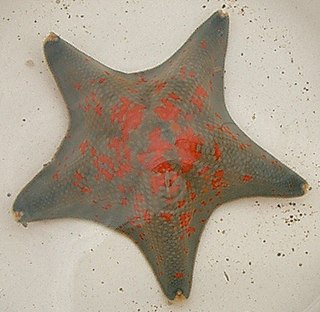
Patiria pectinifera, the blue bat star, is a species of starfish in the family Asterinidae. It is found in the northern Pacific Ocean along the coasts of Japan, China and Russia. It is used as a model organism in developmental biology.
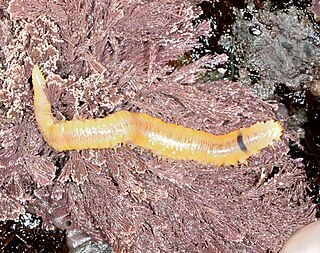
Arctonoe vittata is a species of scaled polychaete worms commonly known as a "scale worm". This species often lives as a commensal of another marine animal.

Coscinasterias muricata is a species of starfish in the family Asteriidae. It is a large 11-armed starfish and occurs in shallow waters in the temperate western Indo-Pacific region.

Starfish, or sea stars, are radially symmetrical, star-shaped organisms of the phylum Echinodermata and the class Asteroidea. Aside from their distinguished shape, starfish are most recognized for their remarkable ability to regenerate, or regrow, arms and, in some cases, entire bodies. While most species require the central body to be intact in order to regenerate arms, a few tropical species can grow an entirely new starfish from just a portion of a severed limb. Starfish regeneration across species follows a common three-phase model and can take up to a year or longer to complete. Though regeneration is used to recover limbs eaten or removed by predators, starfish are also capable of autotomizing and regenerating limbs to evade predators and reproduce.


















